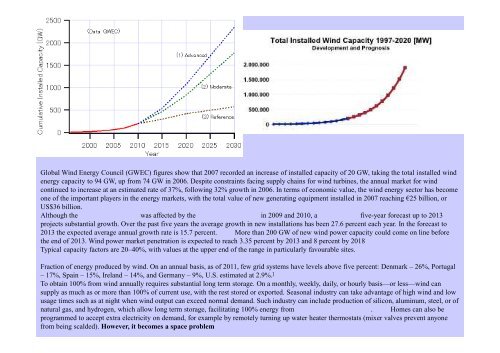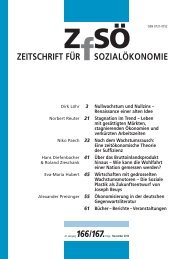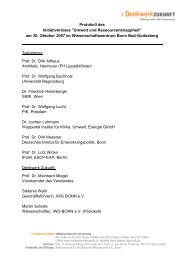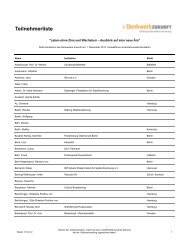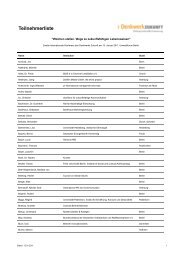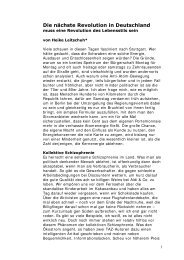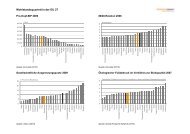Wolfgang Jacoby - Denkwerk Zukunft
Wolfgang Jacoby - Denkwerk Zukunft
Wolfgang Jacoby - Denkwerk Zukunft
Sie wollen auch ein ePaper? Erhöhen Sie die Reichweite Ihrer Titel.
YUMPU macht aus Druck-PDFs automatisch weboptimierte ePaper, die Google liebt.
Global Wind Energy Council (GWEC) figures show that 2007 recorded an increase of installed capacity of 20 GW, taking the total installed wind<br />
energy capacity to 94 GW, up from 74 GW in 2006. Despite constraints facing supply chains for wind turbines, the annual market for wind<br />
continued to increase at an estimated rate of 37%, following 32% growth in 2006. In terms of economic value, the wind energy sector has become<br />
one of the important players in the energy markets, with the total value of new generating equipment installed in 2007 reaching €25 billion, or<br />
US$36 billion. [61]<br />
Although the wind power industry was affected by the global financial crisis in 2009 and 2010, a BTM Consult five-year forecast up to 2013<br />
projects substantial growth. Over the past five years the average growth in new installations has been 27.6 percent each year. In the forecast to<br />
2013 the expected average annual growth rate is 15.7 percent. [48][49] More than 200 GW of new wind power capacity could come on line before<br />
the end of 2013. Wind power market penetration is expected to reach 3.35 percent by 2013 and 8 percent by 2018<br />
Typical capacity factors are 20–40%, with values at the upper end of the range in particularly favourable sites.<br />
Fraction of energy produced by wind. On an annual basis, as of 2011, few grid systems have levels above five percent: Denmark – 26%, Portugal<br />
– 17%, Spain – 15%, Ireland – 14%, and Germany – 9%, U.S. estimated at 2.9%. ]<br />
To obtain 100% from wind annually requires substantial long term storage. On a monthly, weekly, daily, or hourly basis—or less—wind can<br />
supply as much as or more than 100% of current use, with the rest stored or exported. Seasonal industry can take advantage of high wind and low<br />
usage times such as at night when wind output can exceed normal demand. Such industry can include production of silicon, aluminum, steel, or of<br />
natural gas, and hydrogen, which allow long term storage, facilitating 100% energy from variable renewable energy. [73][74] Homes can also be<br />
programmed to accept extra electricity on demand, for example by remotely turning up water heater thermostats (mixer valves prevent anyone<br />
from being scalded). However, it becomes a space problem


